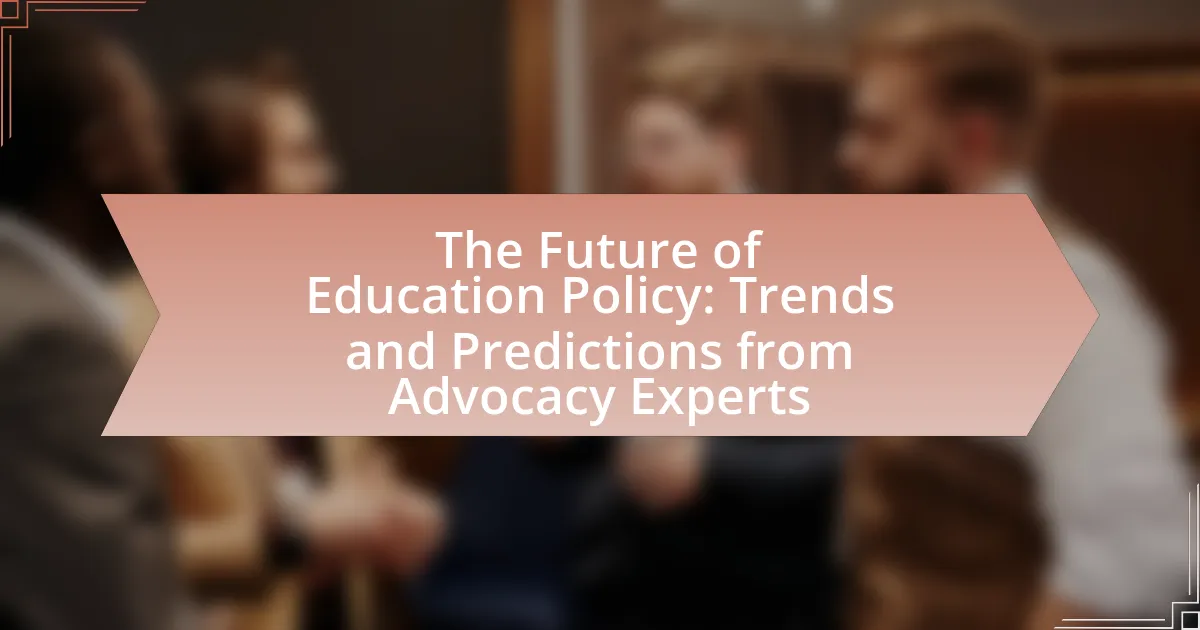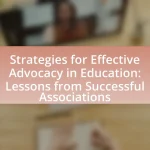The article focuses on the future of education policy, highlighting key trends and predictions from advocacy experts. It discusses the increasing emphasis on equity, the integration of technology, and the importance of mental health in educational settings. The article also examines how demographic changes, technological advancements, and global events, such as the COVID-19 pandemic, are reshaping education frameworks and policies. Additionally, it explores the implications of these trends for funding models, curriculum development, assessment methods, and community engagement in policy-making.
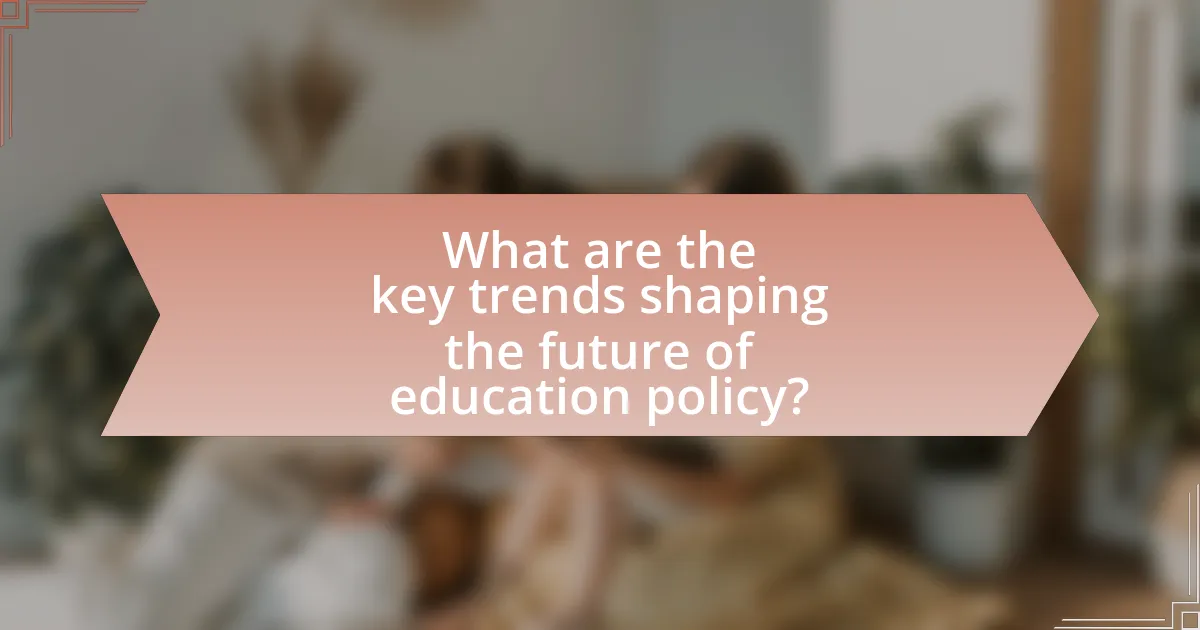
What are the key trends shaping the future of education policy?
Key trends shaping the future of education policy include increased emphasis on equity, integration of technology, and a focus on mental health and well-being. Equity in education policy aims to address disparities in access and outcomes, ensuring that all students receive the resources they need to succeed. The integration of technology, accelerated by the COVID-19 pandemic, has led to a shift towards blended and online learning environments, necessitating policies that support digital infrastructure and training for educators. Additionally, there is a growing recognition of the importance of mental health, prompting policies that incorporate social-emotional learning and support systems within schools. These trends are supported by research indicating that equitable access to resources, effective use of technology, and attention to mental health significantly enhance educational outcomes.
How are technological advancements influencing education policy?
Technological advancements are significantly influencing education policy by driving the integration of digital tools and resources into teaching and learning environments. These advancements necessitate policies that promote access to technology, ensuring equitable opportunities for all students. For instance, the rise of online learning platforms has prompted educational institutions to adapt their policies to support blended learning models, which combine traditional classroom instruction with online components. Additionally, data-driven decision-making has become essential, leading to policies that emphasize the use of analytics to improve student outcomes and tailor educational experiences. Research from the Brookings Institution highlights that technology can enhance personalized learning, prompting policymakers to prioritize funding for digital infrastructure and training for educators.
What role does artificial intelligence play in education policy development?
Artificial intelligence plays a crucial role in education policy development by providing data-driven insights that inform decision-making processes. AI systems analyze vast amounts of educational data, such as student performance metrics and demographic information, to identify trends and gaps in learning outcomes. For instance, a study by the Brookings Institution highlights how AI can help policymakers understand the effectiveness of various educational interventions, enabling them to allocate resources more efficiently and tailor policies to meet the specific needs of diverse student populations. This data-centric approach enhances the ability of education leaders to create evidence-based policies that improve educational equity and quality.
How is online learning reshaping traditional education frameworks?
Online learning is reshaping traditional education frameworks by introducing flexibility, accessibility, and personalized learning experiences. This shift allows students to learn at their own pace and access a wider range of resources and courses, regardless of geographical limitations. According to a report by the National Center for Education Statistics, enrollment in online courses has increased significantly, with over 30% of higher education students taking at least one online course in recent years. This trend indicates a fundamental change in how education is delivered and consumed, leading to a more learner-centered approach that prioritizes individual needs and preferences.
What demographic changes are impacting education policy?
Demographic changes significantly impacting education policy include increasing racial and ethnic diversity, aging populations, and shifts in family structures. The U.S. Census Bureau projects that by 2045, the nation will become majority-minority, necessitating policies that address the needs of diverse student populations. Additionally, as the population ages, there is a growing emphasis on lifelong learning and adult education programs to accommodate older learners. Changes in family structures, such as rising single-parent households, also influence educational support systems and funding allocations. These demographic trends require education policies to adapt in order to ensure equitable access and resources for all students.
How does the increasing diversity of student populations affect policy decisions?
The increasing diversity of student populations significantly influences policy decisions by necessitating the development of inclusive educational frameworks. Policymakers are compelled to address the varied cultural, linguistic, and socio-economic needs of a diverse student body, which can lead to reforms in curriculum design, resource allocation, and support services. For instance, research from the National Center for Education Statistics indicates that schools with higher diversity levels often implement policies aimed at promoting equity and access, such as bilingual education programs and culturally responsive teaching practices. This shift towards inclusivity not only enhances educational outcomes for underrepresented groups but also fosters a more equitable learning environment for all students.
What are the implications of aging populations on education funding and policy?
Aging populations significantly impact education funding and policy by reallocating resources towards elder care and reducing investment in educational initiatives. As the proportion of older individuals increases, governments often prioritize healthcare and pensions, leading to budget constraints for education. For instance, in countries like Japan, where over 28% of the population is aged 65 and older, education budgets have faced cuts, resulting in larger class sizes and fewer educational programs. This trend can hinder educational quality and accessibility, ultimately affecting the workforce’s skill level and economic growth.
What global events are influencing education policy trends?
Global events influencing education policy trends include the COVID-19 pandemic, climate change, and geopolitical tensions. The COVID-19 pandemic has accelerated the adoption of digital learning and highlighted the need for equitable access to technology in education. Climate change has prompted educational institutions to integrate sustainability into curricula, reflecting a growing emphasis on environmental literacy. Geopolitical tensions, such as conflicts and migration crises, have led to increased focus on inclusive education policies that address the needs of displaced populations. These events collectively shape the priorities and frameworks of education systems worldwide, driving reforms and adaptations to meet emerging challenges.
How has the COVID-19 pandemic changed perspectives on education policy?
The COVID-19 pandemic has significantly shifted perspectives on education policy by highlighting the need for flexibility and equity in educational access. Policymakers have recognized that traditional models of education are inadequate in times of crisis, leading to increased emphasis on remote learning and digital resources. For instance, a report from the National Education Association indicated that over 90% of educators believe that the pandemic has exposed systemic inequities in education, prompting calls for reforms that prioritize underserved communities. This shift has resulted in a growing focus on integrating technology into curricula and ensuring that all students have access to necessary resources, thereby reshaping future education policies to be more inclusive and adaptable.
What lessons can be learned from international education responses to crises?
International education responses to crises highlight the importance of adaptability and collaboration. These responses demonstrate that educational systems must quickly pivot to alternative delivery methods, such as online learning, to ensure continuity of education during disruptions. For instance, during the COVID-19 pandemic, UNESCO reported that over 1.5 billion students were affected globally, prompting countries to implement remote learning solutions rapidly. Furthermore, successful responses often involve partnerships between governments, NGOs, and private sectors, as seen in initiatives like the Global Partnership for Education, which mobilizes resources and expertise to support education in emergencies. These lessons emphasize the need for resilient educational frameworks that can withstand future crises while ensuring equitable access to learning opportunities.
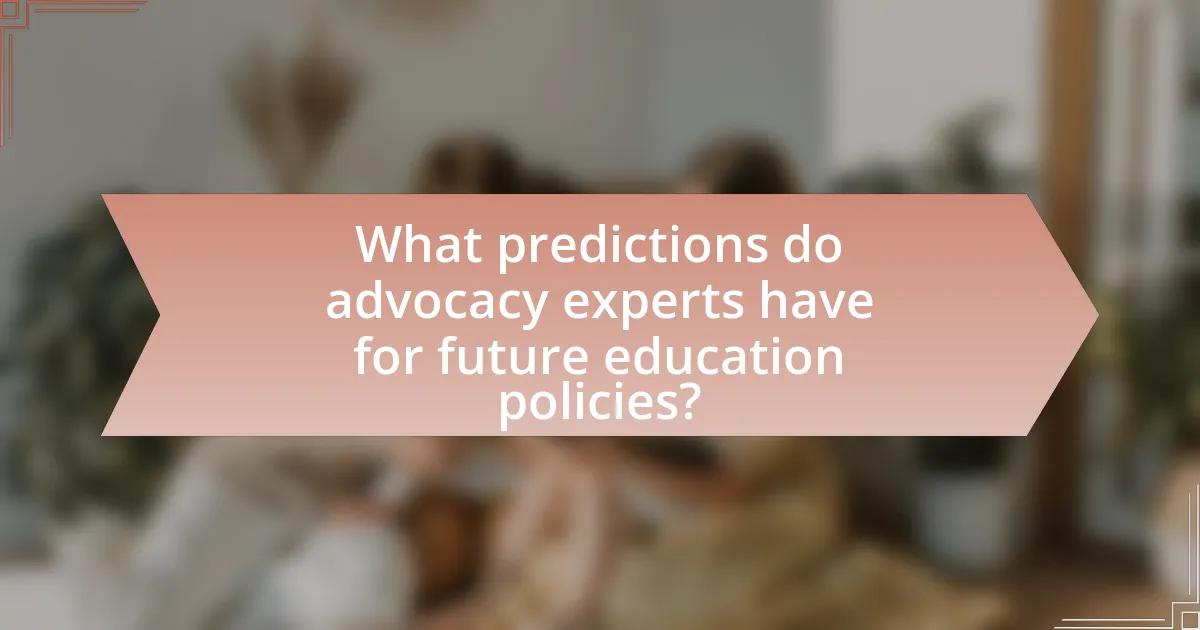
What predictions do advocacy experts have for future education policies?
Advocacy experts predict that future education policies will increasingly focus on equity and access, emphasizing the need to address disparities in educational resources and opportunities. This prediction is supported by ongoing discussions around the impact of socioeconomic status on student achievement, with studies indicating that equitable funding can significantly improve outcomes for underprivileged students. Additionally, experts foresee a rise in policies promoting technology integration in classrooms, driven by the necessity for digital literacy in a rapidly evolving job market. Research from the Brookings Institution highlights that effective technology use can enhance personalized learning experiences, further supporting this trend.
How might funding models evolve in the coming years?
Funding models in education are likely to evolve towards increased flexibility and diversification in the coming years. This evolution will be driven by the need for adaptive funding mechanisms that respond to changing educational demands and technological advancements. For instance, the rise of personalized learning and online education platforms necessitates funding that can support varied instructional methods and student needs. Additionally, data from the National Center for Education Statistics indicates that states are increasingly adopting weighted funding formulas, which allocate more resources to schools serving higher populations of disadvantaged students. This trend suggests a shift towards equity-focused funding models that prioritize access and support for underrepresented groups.
What alternative funding sources are being considered for education?
Alternative funding sources being considered for education include public-private partnerships, crowdfunding, and grants from philanthropic organizations. Public-private partnerships allow for collaboration between government entities and private companies to finance educational initiatives, enhancing resources and infrastructure. Crowdfunding platforms enable individuals and communities to contribute directly to specific educational projects, fostering grassroots support. Additionally, philanthropic organizations, such as the Bill & Melinda Gates Foundation, provide substantial grants aimed at improving educational outcomes, demonstrating a commitment to funding innovative educational programs. These alternative sources are increasingly recognized as vital to supplement traditional funding methods, addressing budget constraints faced by many educational institutions.
How could equity in education funding be achieved?
Equity in education funding could be achieved through the implementation of needs-based funding formulas that allocate resources based on student demographics and local economic conditions. These formulas would ensure that schools serving higher populations of low-income students receive additional financial support, addressing disparities in educational opportunities. Research from the Education Trust indicates that equitable funding can lead to improved student outcomes, as schools with adequate resources are better equipped to provide quality education and support services.
What changes are expected in curriculum development and standards?
Changes in curriculum development and standards are expected to emphasize personalized learning, integration of technology, and a focus on critical thinking skills. Advocacy experts predict that curricula will increasingly incorporate adaptive learning technologies to cater to individual student needs, enhancing engagement and effectiveness. Additionally, there is a trend towards interdisciplinary approaches that connect various subjects, fostering a more holistic understanding of knowledge. Research indicates that these shifts aim to prepare students for a rapidly evolving job market, where skills such as problem-solving and collaboration are paramount.
How will competency-based education influence future curricula?
Competency-based education (CBE) will significantly influence future curricula by prioritizing student mastery of skills and knowledge over traditional time-based metrics. This shift will lead to personalized learning pathways, allowing students to progress at their own pace, which is supported by research indicating that CBE can improve student engagement and outcomes. For instance, a study by the Bill & Melinda Gates Foundation found that schools implementing CBE saw increased student retention and graduation rates, demonstrating the effectiveness of this approach in fostering deeper learning and skill acquisition.
What role will social-emotional learning play in future education policies?
Social-emotional learning (SEL) will play a critical role in future education policies by promoting holistic student development and improving academic outcomes. Research indicates that SEL programs can lead to a 13% increase in student achievement, as demonstrated in a meta-analysis by Durlak et al. (2011) published in the journal Child Development. This integration of SEL into education policies will address the growing recognition of mental health and emotional well-being as essential components of effective learning environments. Furthermore, as educational systems increasingly prioritize equity and inclusivity, SEL will serve as a foundational element in fostering supportive school climates that enhance student engagement and resilience.
What innovations in assessment and evaluation are anticipated?
Anticipated innovations in assessment and evaluation include the integration of artificial intelligence and adaptive learning technologies. These advancements will enable personalized assessments that adjust in real-time to a learner’s performance, providing a more accurate measure of their understanding and skills. Research indicates that AI-driven assessments can enhance learning outcomes by offering tailored feedback and identifying knowledge gaps more effectively than traditional methods. Additionally, the use of data analytics will allow educators to track student progress over time, facilitating more informed instructional decisions.
How might standardized testing evolve in response to new educational needs?
Standardized testing may evolve to incorporate more diverse assessment methods that reflect a broader range of student skills and learning styles. As educational needs shift towards personalized learning and competency-based education, assessments could integrate project-based evaluations, portfolios, and formative assessments alongside traditional tests. Research indicates that such approaches can provide a more comprehensive view of student understanding and capabilities, as evidenced by studies showing improved student engagement and performance when assessments align with real-world applications. This evolution aims to ensure that standardized testing remains relevant and effective in measuring student success in a rapidly changing educational landscape.
What alternative assessment methods are gaining traction among educators?
Alternative assessment methods gaining traction among educators include project-based learning, portfolios, and formative assessments. Project-based learning allows students to engage in real-world problems, fostering critical thinking and collaboration. Portfolios enable students to showcase their work over time, reflecting their learning journey and growth. Formative assessments provide ongoing feedback, helping educators adjust instruction to meet student needs. Research indicates that these methods enhance student engagement and improve learning outcomes, as evidenced by studies showing increased retention and application of knowledge in practical contexts.
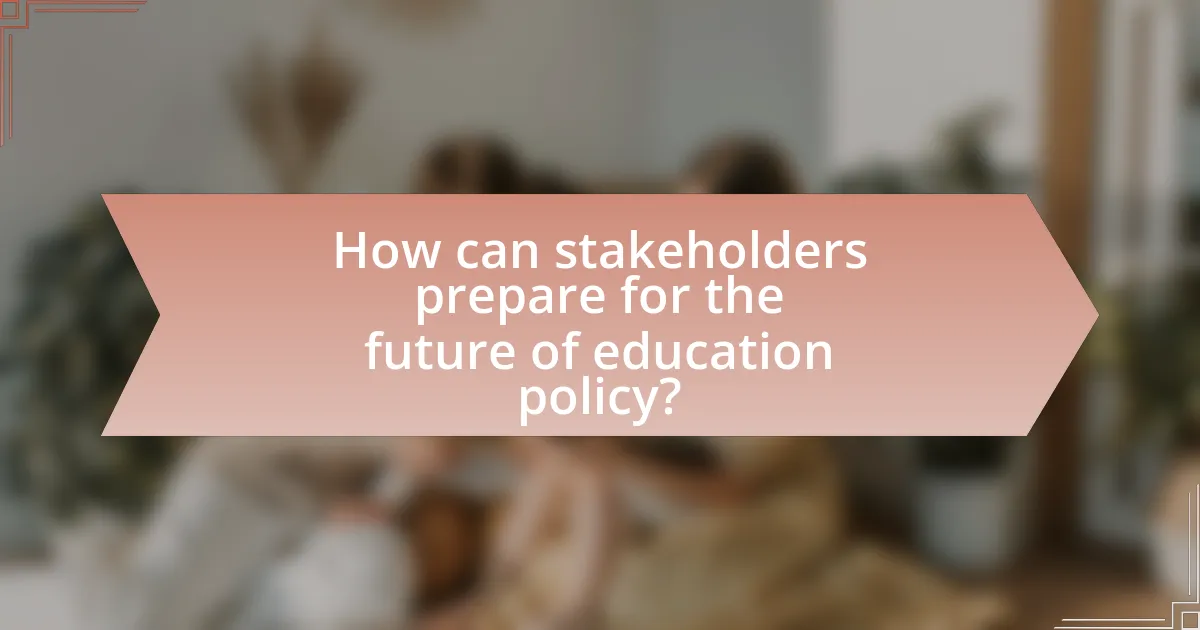
How can stakeholders prepare for the future of education policy?
Stakeholders can prepare for the future of education policy by actively engaging in data-driven decision-making and fostering collaboration among various educational entities. This involves analyzing current trends, such as the increasing integration of technology in classrooms and the emphasis on equity in education, to inform policy development. For instance, a report from the National Center for Education Statistics indicates that technology use in education has grown significantly, highlighting the need for policies that support digital learning environments. Additionally, stakeholders should participate in advocacy efforts to influence legislation that addresses emerging challenges, such as mental health support and access to resources for underserved communities. By staying informed and involved, stakeholders can effectively shape and adapt to the evolving landscape of education policy.
What strategies can educators adopt to adapt to changing policies?
Educators can adopt several strategies to adapt to changing policies, including continuous professional development, collaboration with peers, and active engagement in policy discussions. Continuous professional development allows educators to stay informed about new policies and best practices, enhancing their ability to implement changes effectively. Collaboration with peers fosters a supportive environment where educators can share insights and strategies, making it easier to navigate policy shifts. Active engagement in policy discussions empowers educators to voice their experiences and advocate for practical changes, ensuring that their perspectives are considered in the policymaking process. These strategies are essential for maintaining educational quality and responsiveness in a dynamic policy landscape.
How can professional development be aligned with emerging education trends?
Professional development can be aligned with emerging education trends by integrating current pedagogical research and technology advancements into training programs. For instance, the rise of personalized learning necessitates that educators receive training on adaptive learning technologies and differentiated instruction strategies. Research from the Bill & Melinda Gates Foundation indicates that effective professional development is linked to improved student outcomes when it incorporates evidence-based practices and ongoing support. By focusing on collaboration, data-driven decision-making, and culturally responsive teaching, professional development can effectively respond to the evolving landscape of education.
What role does collaboration among educators play in policy adaptation?
Collaboration among educators plays a crucial role in policy adaptation by fostering shared insights and collective problem-solving. When educators work together, they can identify practical challenges and opportunities within existing policies, leading to more effective and relevant adaptations. Research indicates that collaborative professional development among teachers enhances their ability to influence policy changes, as seen in studies like “Collaborative Professional Development: A Review of the Evidence” by Timperley et al., which highlights that teacher collaboration leads to improved student outcomes and more responsive educational policies. This collaborative approach ensures that policies are informed by real classroom experiences, making them more applicable and beneficial for students and educators alike.
How can policymakers engage with communities to shape effective education policies?
Policymakers can engage with communities to shape effective education policies by implementing participatory approaches that include regular consultations, surveys, and community forums. These methods allow policymakers to gather diverse perspectives and insights directly from stakeholders, ensuring that policies reflect the needs and priorities of the community. For instance, research by the National Education Association indicates that schools with strong community engagement see improved student outcomes and higher satisfaction rates among parents and educators. By fostering open communication and collaboration, policymakers can create more relevant and impactful education policies that resonate with the communities they serve.
What methods can be used to gather community input on education policy?
Surveys and public forums are effective methods to gather community input on education policy. Surveys allow for the collection of quantitative data from a broad audience, enabling policymakers to identify trends and preferences among community members. Public forums facilitate direct dialogue between community members and policymakers, fostering a deeper understanding of local concerns and suggestions. Research indicates that inclusive engagement strategies, such as these, lead to more representative and effective education policies, as evidenced by studies showing that community involvement enhances policy acceptance and implementation success.
How can advocacy groups influence the development of education policy?
Advocacy groups can influence the development of education policy by mobilizing public opinion, providing research and data, and engaging in direct lobbying efforts. These organizations often conduct studies that highlight specific educational issues, such as funding disparities or curriculum needs, which can inform policymakers. For instance, the Education Trust has published reports demonstrating the impact of socioeconomic factors on student achievement, thereby shaping discussions around equitable funding. Additionally, advocacy groups can organize grassroots campaigns that raise awareness and pressure legislators to prioritize certain educational reforms, as seen in the efforts of the National Education Association to promote teacher salary increases. Through these methods, advocacy groups play a critical role in shaping the direction and priorities of education policy.
What best practices should be followed to ensure successful implementation of new policies?
To ensure successful implementation of new policies, it is essential to engage stakeholders throughout the process. Engaging stakeholders, including educators, parents, and community members, fosters buy-in and provides valuable insights that can enhance policy effectiveness. Research indicates that policies with strong stakeholder involvement are more likely to be accepted and successfully executed, as seen in the implementation of the Every Student Succeeds Act, which emphasized collaboration among various educational stakeholders. Additionally, providing clear communication and training about the new policies ensures that all parties understand their roles and responsibilities, further facilitating smooth implementation.
